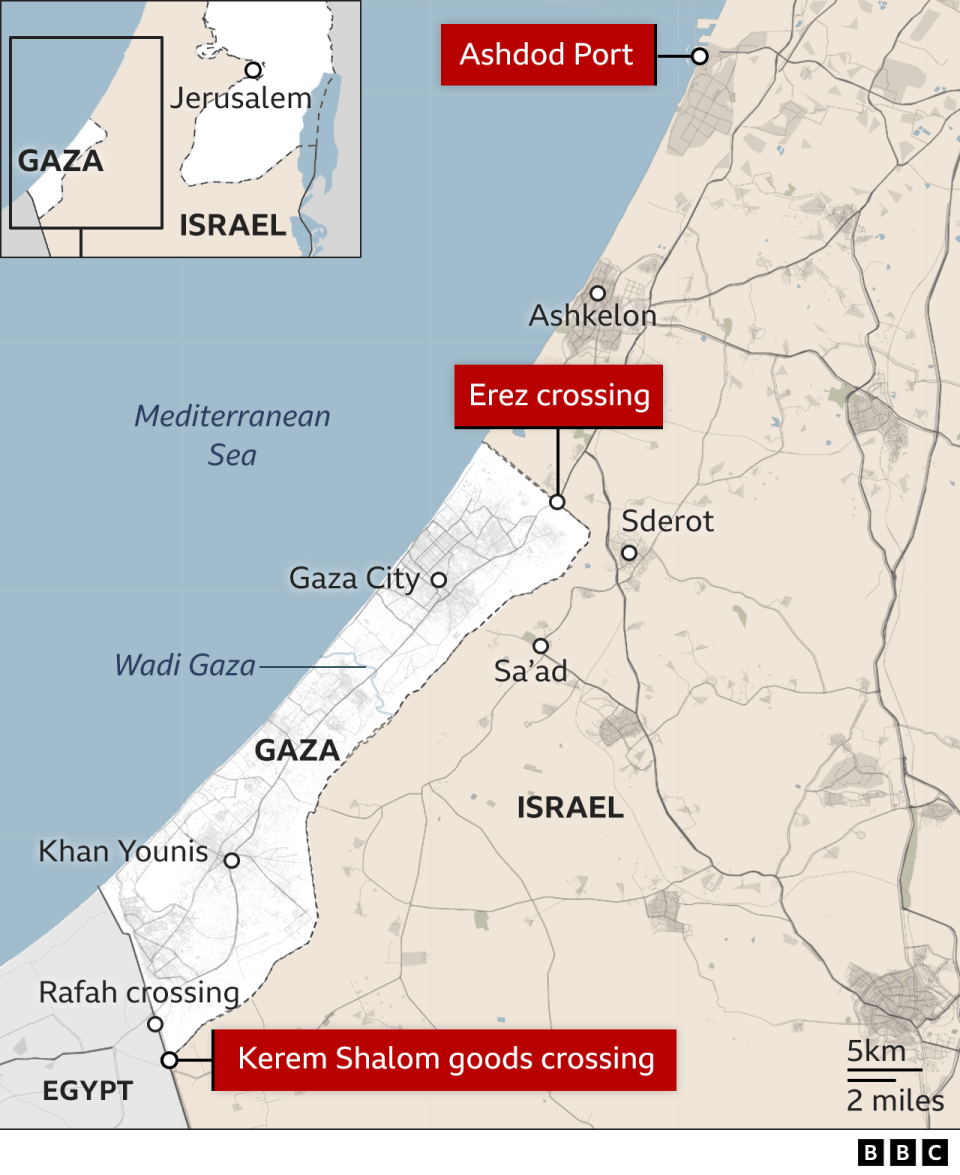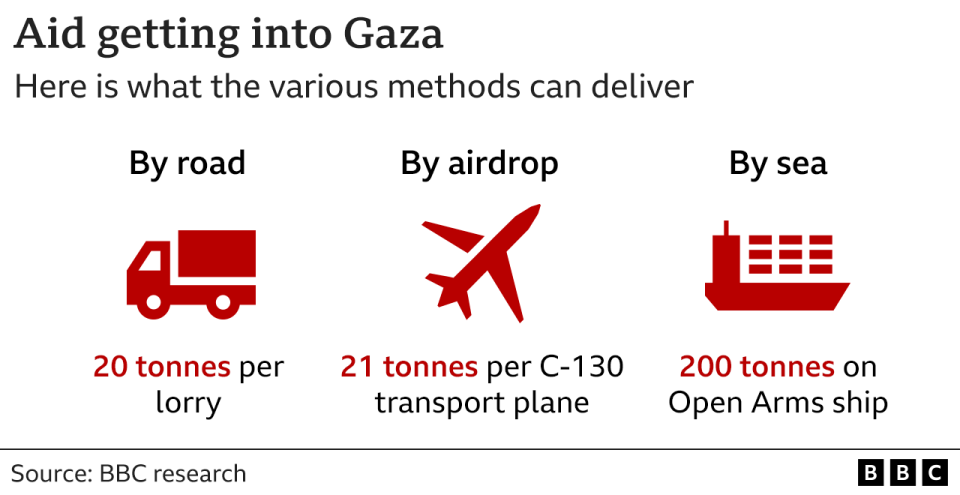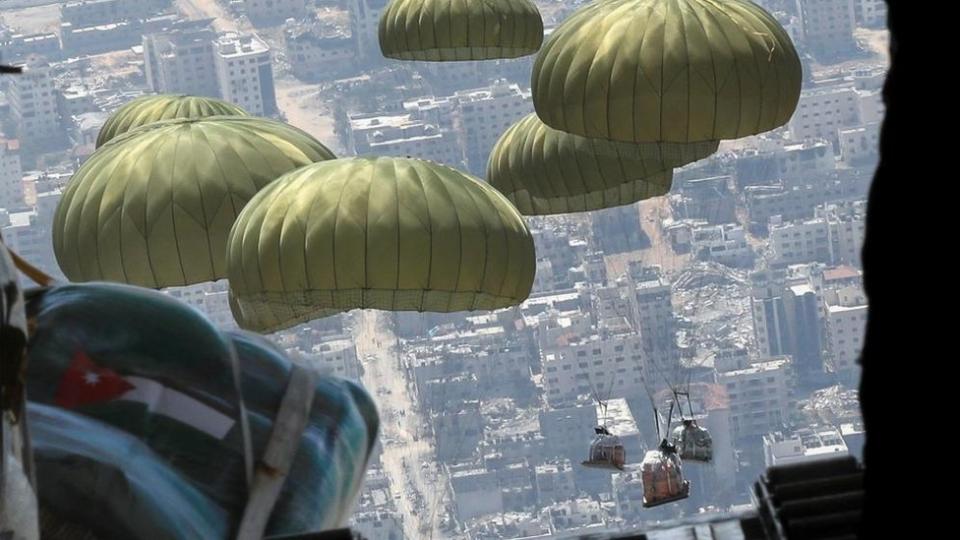Israel says it is building a new land crossing into northern Gaza, where the famine is most acute, after previously promising to open the Erez crossing. The new crossing would accommodate up to 50 aid trucks per day and the first trucks have already crossed it, say Israeli authorities.
Israel also said it will allow the use of the deep-water port of Ashdod, a short distance to the north, as well as allowing more aid into Jordan through the Kerem Shalom crossing in southern Gaza.
On Wednesday, April 10, Israeli Defense Minister Yoav Gallant spoke of gradually increasing aid deliveries to Gaza to pre-war levels of 500 trucks per day.
The number of trucks entering Gaza increased and then decreased throughout the week, with just 147 trucks entering Gaza on Thursday.
It follows the killing of seven aid workers by the Israeli military on April 1, which prompted the US to tell Israel to avoid civilian harm and humanitarian suffering if it wanted to maintain US support.
Israel imposed a siege on Gaza after Hamas attacked nearby Israeli communities, killing about 1,200 people, mostly civilians, and taking about 250 to Gaza hostage. It hit Gaza with an air and ground campaign that killed more than 33,000 people, most of them civilians, according to the Hamas-run health authority.
Since then, Israeli authorities have allowed some aid to enter, but the UN and aid agencies say some children have died from malnutrition.
On Wednesday, USAID Administrator Samantha Power said parts of Gaza were already in famine conditions.
How many trucks are coming in now?
The number of trucks carrying food and other aid entering Gaza increased – but has since declined again.
On April 8, 419 aid trucks arrived, according to Israeli authorities, including 330 trucks carrying food – more than double the average of 140 food trucks per day in March.
However, UN officials told the BBC that the April 8 figure was in fact 223, less than half the daily number they say is needed, at a minimum, to contain the crisis.
UN officials told the BBC the discrepancy occurs because Israeli screening requirements mean trucks are often only half full. After border controls, the goods are transported to a new set of controlled trucks to travel to Gaza, which are filled to near capacity.
On Friday, Cogat, the Israeli body that coordinates government activities in the occupied territories, said that only 147 trucks containing aid entered Gaza, while 208, including just 112 containing food, were distributed inside Gaza.
They included an undisclosed number of food trucks that entered through the new border crossing into northern Gaza, which Israeli media reported was near kibbutz Zikim, west of the Erez crossing.

The Israeli military said the trucks were accompanied by soldiers from the Israel Defense Forces (IDF).
On Friday, Philip Lazzarini, head of the UN agency for Palestinian refugees, UNRWA, said the increase in aid was “not yet tangible, sustained or uninterrupted”.
Blame game for violence and hunger
Aid agencies, Israel’s allies and other countries have accused Israel of not doing enough to ensure food reaches those who need it. Some accused Israel of using hunger as a weapon of war.
All aid to Gaza is subject to strict Israeli security controls, designed to prevent the entry of anything that could be used by Hamas. But aid groups say these measures are complex and arbitrary, causing long delays.
Israel has denied having prevented aid from entering Gaza and accuses humanitarian organizations of not having distributed it. On Thursday, Cogat said the contents of hundreds of aid trucks were waiting to be picked up inside Gaza and said: “UN, do your job. The bottlenecks are not on the Israeli side.”
As conditions deteriorated, aid deliveries inside Gaza were also accompanied by deadly violence.
In one incident, the Israeli military killed seven aid workers who worked for World Central Kitchen (WCK), a charity that Israel worked with to distribute aid by boat from Cyprus. Israel apologized and took action against the unit involved.
There have been regular reports of shooting at Palestinians who gathered to receive what little aid has reached northern Gaza. The Hamas-run health ministry in Gaza and local Palestinians have accused Israeli forces of shooting at desperate people. In the bloodiest incident, more than 100 people were killed on February 29 when a convoy arrived at al-Rashid Street in Gaza City.
Israel denied involvement in the deaths, saying that Palestinians were crushed to death, run over by trucks and shot by armed Palestinians, and that when Israeli troops opened fire it was on people they considered “suspicious”.
Israel banned UNRWA from providing aid to northern Gaza due to allegations that some UNRWA officials participated in the October 7th Hamas attack. Cogat said Israel would work with organizations that are “not involved in terrorism.”
The Crisis Group think tank described Israel’s approach to aid distribution as a “fiasco”, accusing it of “failing to coordinate military action with humanitarian action”. He also said that Israel was trying to bypass the international aid system and instead use aid convoys as a way of trying to build a network of actors to manage Gaza after the war.
“It targets aid to large families who agree to embrace its agenda, while targeting those who refuse,” the think tank said.
The UN’s top human rights official, Volker Türk, recently said in a BBC interview that Israel was significantly to blame and that there was a “plausible” case that Israel was using famine as a weapon of war in Gaza.
Mr Türk, who is the UN High Commissioner for Human Rights, said that if intent were proven, it would amount to a war crime.
Israeli Economy Minister Nir Barkat dismissed Türk’s warnings as “completely absurd – a completely irresponsible thing to say.”
What is Ashdod Port and how can it help?
The port of Ashdod, 32 km north of Gaza, is one of Israel’s three main cargo ports and can handle more than 1.5 million containers a year.
However, there were no reports of aid shipments for Gaza received in Ashdod. On Wednesday, Israel’s Channel 12 reported that no preparations had been made to open Ashdod to humanitarian shipments.
As not enough aid has reached Gaza by land, countries have tried alternative routes via the skies and sea – but these too have been beset by problems.
Of the two schemes to bring food and other aid to Gaza by sea, only one began operating and has now been halted after the Israeli military attacked WCK, the aid agency that unloaded and distributed aid from a pier that had built from rubble, Pedregulho.


Last month, the first ship to arrive in Gaza under the scheme arrived from Cyprus – the EU country closest to Gaza – towing a barge carrying around 200 tonnes of food supplied by WCK.
At the end of March, the head of WCK José Andrés said that 67 WCK kitchens were operating in Gaza, feeding 350,000 people a day.
Meanwhile, a separate US military plan is underway, with a US Navy ship en route carrying materials to build a floating dock and pierto allow supplies from much larger cargo ships to reach shore.
According to the US Department of Defense, this will mean that two million meals a day will be able to enter Gaza. But it’s not expected to be ready for months.
Using air drops


The US, Jordan, Egypt, France, the Netherlands and Belgium are among the countries that have launched aid in Gaza, but aid groups say the technique is a last resort that alone cannot satisfy the need.
At least 20 Palestinians were killed during airdrops – five when the parachute on an aid package failed to open and the box fell onto people waiting below, and the others when aid packages fell into the sea and desperate people drowned as they they tried. to recover them.
Air forces such as the United Kingdom’s RAF typically drop aid at an altitude as low as 400 feet (120 m), but the Israelis have stipulated that they must not do so below 2,000 feet (610 m). This means that parachutes take a long time to be deflected by the wind, which is why some air drops in recent weeks have landed at sea.
A C-130 transport plane can carry 21 tons of aid – about the same amount that can be transported by a single truck. There is also no way to organize distribution on the ground.
The decline of first aid across the US of March 3, carried out jointly with Jordan, contained enough food for more than 38 thousand meals. On April 11, US Central Command, or Centcom, said the US had delivered 855 tons of humanitarian assistance in total.

































